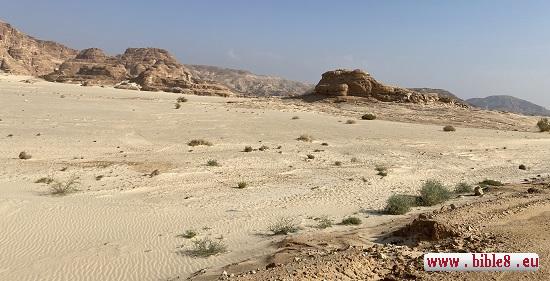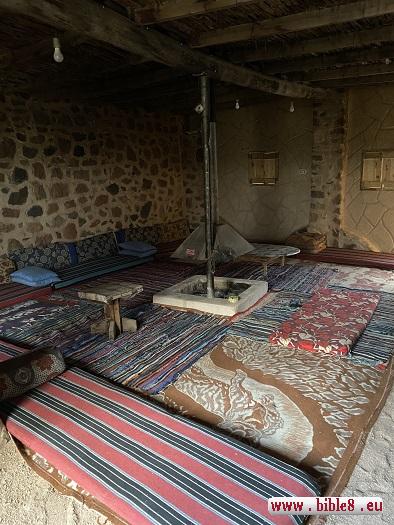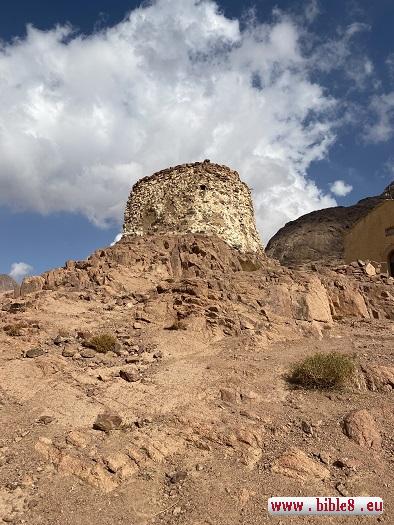
Sinai Peninsula 🏜
Archaeology, History, and Biblical Significance
The Sinai Peninsula is located in the northeast of Egypt and represents a unique region that served as a bridge between Africa and Asia. Its strategic location made it the scene of numerous historical events and cultural interactions. Since antiquity, the Sinai Peninsula has been a place for trade routes, military campaigns, and religious pilgrimages.

Typical landscape of the Sinai Peninsula
⇒ Geography and Natural Features
The peninsula has the shape of a triangle, bounded to the west by the Gulf of Suez, to the east by the Gulf of Aqaba, and to the north by the Mediterranean Sea. Its area is approximately 60,000 square kilometers. The landscape of Sinai is diverse: from mountains in the south to desert plains and oases in the north.
⇒ Archaeological Discoveries
Serabit el-Khadim
In the southwest of Sinai lies Serabit el-Khadim – an ancient center for turquoise mining, actively used by the Egyptians during the Middle and New Kingdoms. In the early 20th century, the British archaeologist Sir Flinders Petrie discovered unique inscriptions here, known as the Sinai Inscriptions, which date to the 19th–18th century BC. They are considered one of the earliest forms of alphabetic writing – a transition between Egyptian hieroglyphs and the Phoenician alphabet. The invention of the alphabet is attributed in legends to Moses. In reality, the alphabet is one of humanity’s greatest inventions: instead of thousands of images (hieroglyphs), the Hebrew alphabet used just over twenty symbols, which did not depict things but stood for specific sounds.
Tell el-Farama
In April 2022, archaeologists discovered a 1.3 km long and about 2-meter-high underground tunnel 13 meters deep in the Tell el-Farama region (ancient Pelusium). This structure, similar to the Tunnel of Samos in Greece, testifies to the high level of engineering of ancient builders and points to a sophisticated infrastructure in the region.
Tell Habua
In 2025, remains of a 3,500-year-old structure were discovered at the Tell Habua archaeological site in the northeast Sinai Peninsula, which likely served as a royal retreat during the reign of Pharaoh Thutmose III (c. 1479–1425 BC). This discovery underscores the strategic importance of the region during the New Kingdom and its role in securing Egypt's eastern borders.
The Oldest Fortress
In 2019, Egyptian archaeologists discovered one of the oldest known Egyptian fortresses on the Sinai Peninsula, dated to the 26th Dynasty (7th–6th century BC). Remains of two towers and wall fragments with a length of 85 meters were found – evidence of the region’s military importance in the Late Period of Ancient Egypt.
⇒ Biblical Significance
Mount Sinai and the Monastery of Saint Catherine, founded in the 6th century by the Byzantine Emperor Justinian I, are among the oldest still-active Christian monasteries in the world. The monastery is believed to be located at the site where God appeared to Moses in the burning bush. Not far from the monastery lies the mountain where Moses is traditionally believed to have received the Ten Commandments from God. Today, the monastery houses a museum open to tourists, and also offers accommodation for pilgrims. The region is also inhabited by Bedouins who have established their villages here. The monastery library contains one of the most extensive collections of ancient manuscripts – only the Vatican Library holds more. Among them is the famous Codex Sinaiticus from the 4th century, one of the oldest surviving biblical texts.
Wadi Feiran, located in the center of the peninsula, is equated with the biblical Rephidim, where the Israelites camped during their exodus from Egypt. The 2070-meter-high Mount Serbal is also considered by some researchers to be a possible site of the giving of the Law.
According to the map, this is the tomb of Aaron. However, some claim it is located elsewhere. Near this ancient tomb, however, a Greek church was built, which is a clear sign of its biblical significance.
⇒ Cultural and Ethnic Influences

Room in a Bedouin house on the Sinai Peninsula. The house is located close to historical sites where the Israelite people roamed, pitched, and dismantled their tents thousands of years ago. Their tents may have looked like this or similar.
For thousands of years, Sinai has been a crossroads of cultures. Egyptians, Canaanites, Midianites, Jews, Persians, Greeks, Byzantines, Arabs, and even Crusaders left their marks here.
⇒ Modern Research and Significance
Since the beginning of the 20th century, Sinai has attracted archaeologists, theologians, and geopoliticians. Particularly active in the 20th century were British and Israeli research missions.
Today, the region is of great interest both to biblical scholars and historians of the Middle East. Modern technologies such as satellite imagery, LIDAR, and radiocarbon dating allow for more accurate localization of ancient routes and settlements.
Sinai remains a politically sensitive region: it is divided into administrative units, suffers from poverty, and is developing primarily as a destination for ecological and religious tourism.
Still from the film ‘The Exodus Decoded’. On the rock are images of fish, water, and a bull’s head. In modern Hebrew script, the shapes have changed, but originally the letters looked exactly like those on the rock. For example, the first letter Aleph – originally a bull. The letter M (Mem), from the word “Maijim” (water), is shown here as a wave.
The filmmaker Simcha Jacobovici is sitting in a cave that he believes was once worked by Hebrew slaves. He is looking at an inscription in ancient Hebrew script: “God, save me!” – a possible archaeological testimony to biblical events. The Egyptians were polytheists, while the Hebrews were monotheists. Jacobovici is himself Jewish, and it is moving how a descendant reverently contemplates an ancient prayer inscription of his ancestors.
2025
Donation
© 2012 - 2025

